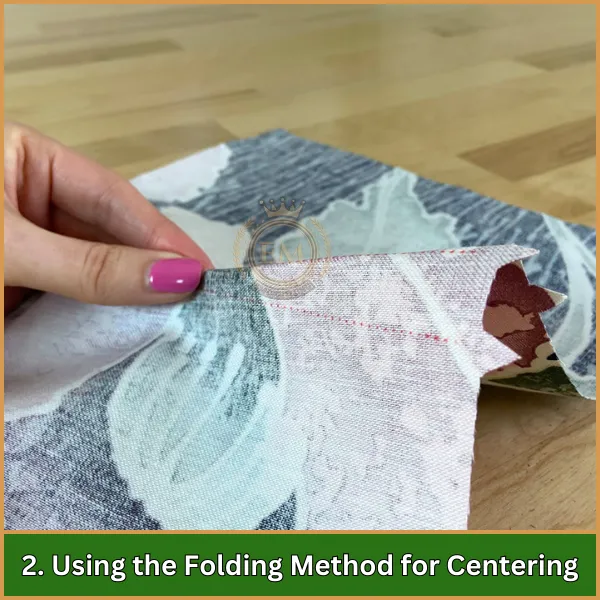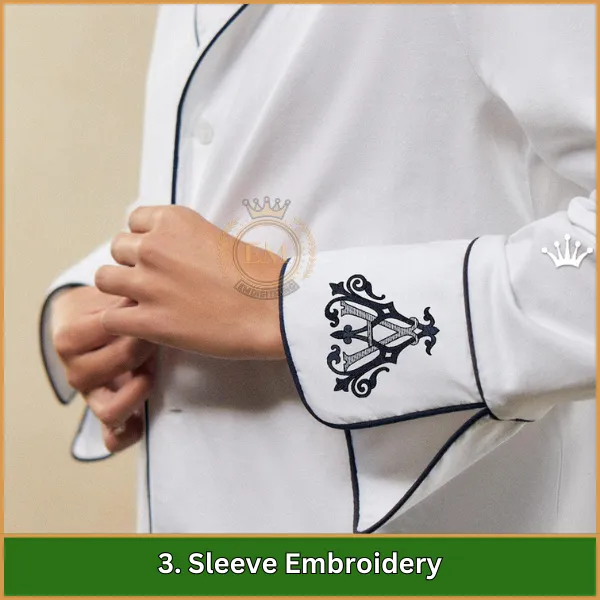Haben Sie Probleme mit der Platzierung von Stickereien und möchten sicherstellen, dass Ihre Designs jedes Mal perfekt aussehen?? Mach dir keine Sorge, Du bist nicht allein!
Es kann schwierig sein, die richtige Platzierung zu finden, aber mit ein paar einfachen Tipps, es wird viel einfacher. Whether you’;Ich füge einem T-Shirt ein Logo hinzu, Ein Motiv auf eine Mütze nähen, oder eine Jacke verzieren, Die richtige individuelle Platzierung macht den Unterschied.

In diesem Ratgeber, Wir führen Sie durch die besten Methoden, um sicherzustellen, dass Ihre Designs zentriert sind, ausgerichtet, und auf jedem Kleidungsstück professionell aussehen.
Lassen Sie uns eintauchen und Ihre Stickprojekte durch makellose Platzierung hervorheben!
Beherrschen der Platzierung von Stickereien: Tipps für perfekte Ergebnisse
Bedeutung der korrekten Platzierung der Stickerei
Die richtige Platzierung ist der Schlüssel zum Erstellen professionell aussehender Stickereien. Es sorgt dafür Maschinenstickerei-Designs werden konsistent platziert und sehen auf dem Endprodukt gut aus.
Eine falsche Platzierung kann dazu führen, dass Designs schief oder falsch platziert aussehen, Dadurch sieht das Kleidungsstück unattraktiv aus. Zum Beispiel, Ein falsch platziertes Logo auf einem Ärmel könnte unangenehm aussehen und den Stoff beschädigen oder zu Nadelbrüchen führen.
Es ist wichtig, einen klaren Plan für die Platzierung der Stickerei zu haben, insbesondere bei der Arbeit mit Kunden. Es trägt dazu bei, Designerwartungen zu klären und Fehler zu reduzieren.
Techniken wie das Falten von Stoff oder die Verwendung präziser Markierungen tragen dazu bei, dass Designs zentriert und auf verschiedenen Kleidungsstücken ausgerichtet sind. Diese Liebe zum Detail verbessert die Qualität der Stickerei und schafft Vertrauen bei Kunden, die qualitativ hochwertige Arbeit erwarten.
Unverzichtbare Werkzeuge für die präzise Platzierung von Stickereien
Eine präzise Platzierung ist der Schlüssel zur Schaffung hochwertiger Produkte, optisch ansprechende Designs. Um dabei zu helfen, Mehrere Werkzeuge sind unerlässlich:
- Mess- und Markierungswerkzeuge
- Stickrahmen
- Digitale Tools und Software
- Stabilisatoren
- Platzierungsaufkleber
1. Mess- und Markierungswerkzeuge

Genaue Messungen sind entscheidend für die perfekte Designplatzierung. Für die individuelle Platzierung sind Werkzeuge wie Lineale und Maßbänder erforderlich, um die beste Stelle für Ihr Design auf dem Stoff zu finden.
Temporäre Markierungswerkzeuge wie Kreide und Markierungsstifte sind ebenfalls unverzichtbare Utensilien, um deutlich zu markieren, wo gestickt werden soll, Stellen Sie sicher, dass das Design beim Aufstellen sichtbar ist.
2. Stickrahmen

Die Wahl des richtigen Stickrahmens ist entscheidend, um die Stabilität des Stoffes zu gewährleisten und sicherzustellen, dass die Stiche präzise sind. Ein Rahmen, der etwas größer als das Design ist, hilft, ein Ziehen und Falten des Stoffes zu vermeiden. Richtige Rahmenausrichtung, like making sure it’;Es ist zentriert und eben, ist entscheidend, um die besten Ergebnisse zu erzielen.
3. Digitale Tools und Software

In moderner Stickerei, Spezielle Software eignet sich hervorragend zum Erstellen digitaler Versionen von Maschinenstickdesigns und zum Anpassen dieser, bevor Sie mit dem Sticken beginnen.
Diese Technologie macht es einfacher, präzise zu sein und ermöglicht Stickern, bei der individuellen Platzierung kreativer zu sein.
4. Stabilisatoren
Die Verwendung des richtigen Vlieses ist ein Muss, damit der Stoff beim Sticken seine Form nicht verändert. Es gibt verschiedene Arten von Stabilisatoren, wie wegreißen oder wegschneiden, die gut mit verschiedenen Stoffen und Designdetails harmonieren. Sie tragen dazu bei, Probleme wie Stoffverschiebungen oder Faltenbildung zu reduzieren.
5. Platzierungsaufkleber

Platzierungsaufkleber erleichtern das Markieren, wo die Nadel platziert werden soll. They’;Sie sind wiederverwendbar und hinterlassen weniger Rückstände auf der Kleidung als andere Markierungsmethoden, Dies macht sie zu wichtigen Gegenständen für eine präzise Platzierung.
Techniken für eine genaue Platzierung
Hier sind drei einfache Techniken für die präzise Platzierung von Stickereien, Stellen Sie sicher, dass Ihre Projekte professionell aussehen:
- Punktgenaue Platzierungsmethode
- Verwendung der Faltmethode zur Zentrierung
- Verwendung von Platzierungslinealen und Diagrammen
1. Punktgenaue Platzierungsmethode

This method utilizes your embroidery machine’;Es verfügt über integrierte Funktionen zur genauen Lokalisierung der Nahtstellen.
Zuerst, Wählen Sie Ihr Design auf der Maschine aus und ändern Sie die Größe, Zeichnen Sie dann vertikale und horizontale Mittellinien auf dem Stoff ein, auf denen das Design platziert werden soll.
Diese präzise Markierung sorgt für eine perfekte Ausrichtung, Ideal für komplexe Designs oder spezifische Platzierungen wie Logos auf Hemden oder Jacken.
2. Verwendung der Faltmethode zur Zentrierung

Zum einfachen Zentrieren, Legen Sie den Stoff flach und falten Sie ihn sowohl vertikal als auch horizontal, um in der Mitte Faltlinien zu erzeugen. Markieren Sie diese Mittelpunkte mit einem stoffsicheren Stift oder Kreide.
Richten Sie das Design an diesen Markierungen aus, um ein symmetrisch platziertes Design zu erhalten. Diese Technik eignet sich besonders für Kleidungsstücke wie T-Shirts oder Tragetaschen, wo zentrierte Designs die visuelle Attraktivität steigern.
3. Verwendung von Platzierungslinealen und Diagrammen
Platzierungslineale und Diagramme sind für eine konsistente Designpositionierung unerlässlich. Legen Sie das Lineal auf den Stoff und markieren Sie die Platzierungspunkte des Motivs mit Schneiderkreide oder abwaschbaren Markern.
Diese Tools sorgen für Einheitlichkeit über verschiedene Projekte hinweg. Druckbare Platzierungstabellen können auch während der Kundenberatung verwendet werden, um klare Erwartungen für die Designplatzierung festzulegen.
Richtlinien für die Platzierung von Stickereien auf verschiedenen Kleidungsstücken
Hier ist eine einfache Schritt-für-Schritt-Anleitung, die Ihnen hilft, Stickereien auf verschiedenen Kleidungsstücken präzise anzubringen.
1. Hemden: Platzierungen auf der linken Brust und in der Mitte
- Schritt 1: Legen Sie das Hemd flach auf eine Oberfläche.
- Schritt 2: Für die Platzierung auf der linken Brust, etwa messen 6-8 Zoll von der Schulternaht entfernt und 3-4 Zoll von der Mitte des Hemdes entfernt.
- Schritt 3: Markieren Sie die Platzierungsstelle leicht mit einem abwaschbaren Marker oder Kreide.
- Schritt 4: Zentrieren Sie das Design im markierten Bereich und spannen Sie den Stoff sicher ein, Anpassung je nach Stoffart für optimale Nähte.
2. Jacken und Hoodies: Rücken- und Ärmelplatzierung
- Schritt 1: Zur Rückenplatzierung, Messen Sie ungefähr ab 7-9 Zoll vom Hals entfernt.
- Schritt 2: Markieren Sie bei großen Motiven die Mitte der Rückseite.
- Schritt 3: Zur Platzierung der Ärmel, Markieren Sie eine Stelle in der Nähe der Manschette oder der Mitte des Ärmels.
- Schritt 4: Secure the fabric in a hoop and make sure it’;s straff.
3. Mützen und Hüte: Vorder- und Seitenplatzierung
- Schritt 1: Verwenden Sie zum Sticken einen hutspezifischen Stickrahmen.
- Schritt 2: Zur Frontplatzierung, Markieren Sie die Mitte der Kappe direkt über dem Geldschein.
- Schritt 3: Zur seitlichen Platzierung, Markieren Sie eine Stelle etwas oberhalb des Ohrbereichs.
- Schritt 4: Befestigen Sie die Kappe im Reifen, Stellen Sie sicher, dass das Design zentriert ist.
4. Zubehör: Stickereien auf Taschen und anderen Artikeln

- Schritt 1: Legen Sie die Tasche flach hin und markieren Sie die Mitte der Frontplatte.
- Schritt 2: Stellen Sie sicher, dass das Design gut in den markierten Bereich passt.
- Schritt 3: Befestigen Sie den Stoff mit einem flachen Rahmen oder Rahmen.
- Schritt 4: Überprüfen Sie die Platzierung noch einmal, bevor Sie mit dem Nähen beginnen.
Erweiterte Tipps für die Platzierung von Stickereien
Um eine präzise Platzierung zu erreichen, sind mehr als nur grundlegende Werkzeuge erforderlich; Fortgeschrittene Techniken können Ihre Ergebnisse erheblich verbessern. Hier finden Sie einige hilfreiche Tipps:
- Verwenden Sie Platzierungsaufkleber: Platzierungsaufkleber helfen dabei, Ihre Nadel an der Mitte des Motivs auszurichten. Diese wiederverwendbaren Aufkleber erleichtern die perfekte Platzierung, ohne Rückstände auf dem Stoff zu hinterlassen.
- Erstellen Sie einen Platzierungsplan: Ein Plan sorgt für konsistente Ergebnisse. Verwenden Sie Platzierungstabellen, um die richtigen Stellen für Logos oder Designs auf verschiedenen Kleidungsstücken zu markieren, hilft, Fehler zu vermeiden und die Kundenzufriedenheit sicherzustellen.
- Testen Sie vor der Fertigstellung: Testen Sie immer zuerst Stoffreste, bevor Sie das eigentliche Kleidungsstück annähen. Auf diese Weise können Sie die Designplatzierung anpassen und etwaige Probleme mit der Fadenart oder dem Stoff erkennen.
- Berücksichtigen Sie die Stoffeigenschaften: Verstehen Sie, wie sich verschiedene Stoffe verhalten. Dehnbare Materialien benötigen möglicherweise spezielle Stabilisatoren, um zu verhindern, dass sich das Design beim Nähen verschiebt oder verformt.
- Verwenden Sie Mock-Up-Techniken: Mit digitalen Modellen können Sie visualisieren, wie das Design auf dem Kleidungsstück aussehen wird, So können Sie vor dem Nähen Änderungen vornehmen, um Platzierungsfehler zu vermeiden.
Indem Sie diese Tipps befolgen, Sie können Ihre verbessern Maschinenstickerei Platzierung und schaffen mehr poliert, professionelle Maschinenstickerei-Designs.
Kreative Platzierungsideen zur Personalisierung Ihrer Projekte
Personalisierung Ihres Stickprojekte Mit einzigartigen Platzierungen können einfache Gegenstände in besondere Andenken verwandelt werden. Hier sind einige kreative Ideen:
1. Stickerei auf der linken Brust

Ein klassischer Ort für Logos oder Initialen, Diese Platzierung eignet sich gut für Hemden und Jacken, verleiht eine subtile, aber stilvolle Note.
2. Designs mit vollem Rücken

Für ein großes, mutiges Design, Die gesamte Rückseite von Jacken oder Hoodies bietet viel Platz, perfekt für herausragende Kunstwerke oder detaillierte Designs.
3. Ärmelstickerei

Ärmel eignen sich hervorragend zum Hinzufügen kleiner Logos oder Muster. Das Besticken des Bizeps oder das Umwickeln des Ärmels mit einem Motiv sorgt für zusätzlichen Spaß, kreatives Element.
4. Hut- und Mützenstickerei
Etwas oberhalb der Kappenmitte platzierte Designs sorgen für Sichtbarkeit. Diese Platzierung ist perfekt für individuelle Platzierung auf Werbehüten oder Freizeitkleidung.
5. Kreative Raumnutzung

Erwägen Sie, Stickereien entlang der Seitennähte anzubringen, auf Taschen, oder Innenkragen für einen unerwarteten und einzigartigen Look.
6. Saisonale Themen
Fügen Sie saisonale Designs wie Schneeflocken im Winter oder Blumen im Frühling hinzu, um Ihre Stickprojekte festlicher und geschenkwürdiger zu machen.
7. Gedenktermine
Sticken Sie wichtige Daten, wie Jubiläen oder Geburtstage, in eleganten Schriftarten zur individuellen Gestaltung, unvergessliche Gegenstände.
Fazit: Erhalten Sie die perfekte Platzierung mit EMdigitizing!
Mit den richtigen Stickplatzierungstechniken in der Hand, Ihr nächster Schritt besteht darin, sicherzustellen, dass Ihre Designs zum Sticken bereit sind. EMdigitalisieren ist hier, um Ihnen zu helfen, indem wir Ihre Designs in hochwertige Designs umwandeln, Stickdateien schnell und kostengünstig zum Sticken bereit.
Wir kümmern uns um den Digitalisierungsprozess, So können Sie sich darauf konzentrieren, makellose Ergebnisse zu erzielen, Jedes Mal eine gut platzierte Stickerei.
Vertrauen Sie EMdigitizing die technischen Details an, Machen Sie Ihre Stickprojekte einfacher und professioneller!
Häufig gestellte Fragen
Bei der Platzierungsstickerei wird Ihr Design an der richtigen Stelle auf dem Stoff platziert. Es trägt dazu bei, dass das Design ordentlich und gut positioniert aussieht.
Sie können a zentrieren Stickerei-Design indem Sie den Stoff falten, um Falten zu erzeugen und den Mittelpunkt markieren. Dann, Richten Sie Ihr Design an dieser Markierung aus.
Legen Sie den Stoff in den inneren Rahmen und drücken Sie den äußeren Rahmen darauf. Stellen Sie sicher, dass der Stoff fest und zentriert im Stickrahmen liegt, um ein gleichmäßiges Nähen zu gewährleisten.
Ein Platzierungsleitfaden gibt die besten Plätze für Designs an, B. Logos auf der linken Brust bei Hemden oder größere Designs auf der Rückseite von Jacken.
Ein Platzierungsstich ist ein leichter Stich, der zeigt, wohin das Hauptmuster gehen wird. Dadurch wird sichergestellt, dass das Design vor dem Start richtig platziert wird.
